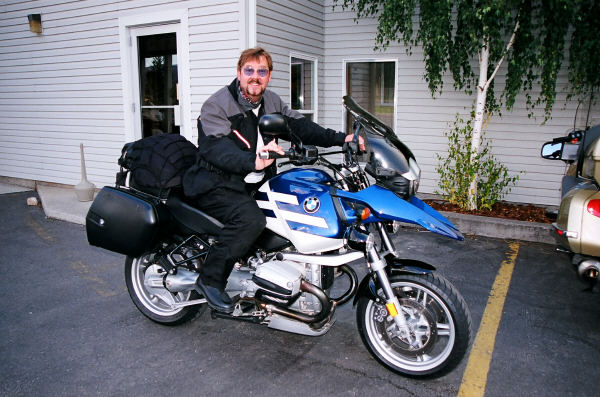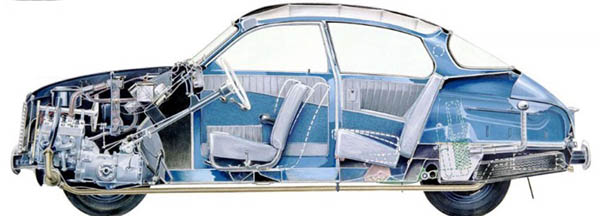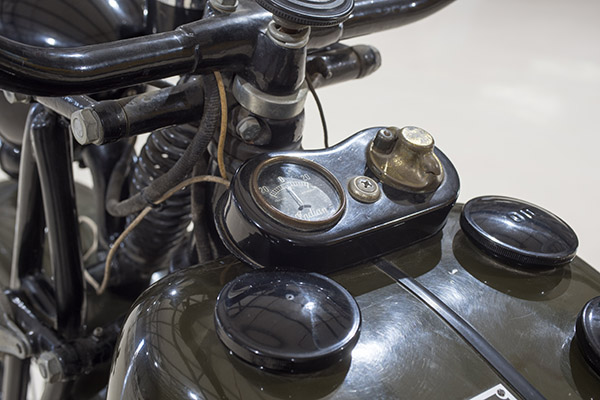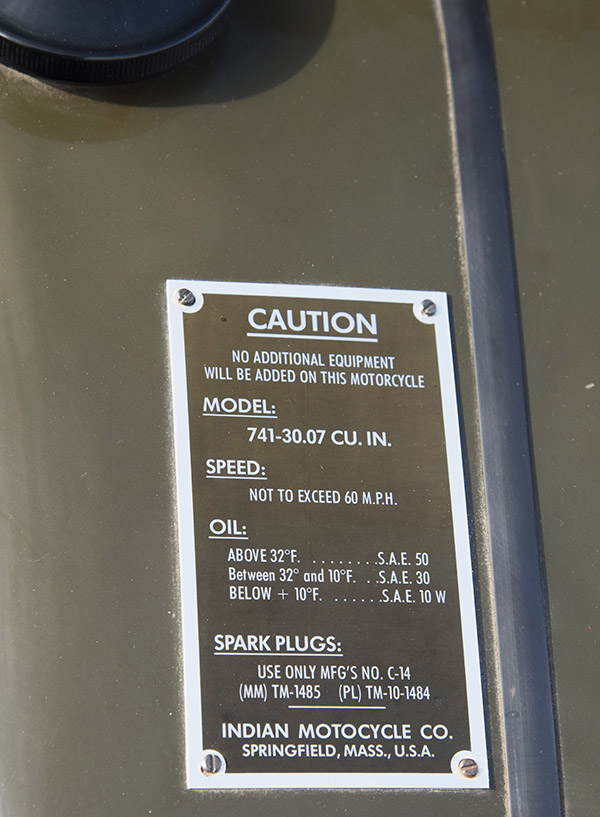
Way south-er than you’ve ever been, on the south end of the south island of New Zealand, there lived a motorcyclist named Burt Munro. For a country with a total population less than half of the Los Angeles basin, New Zealanders have an uncanny habit of punching far above their weight (see: rugby, wool). Burt Munro was no different. A pre-digital version of John Britten, he singlehandedly modified an ancient Indian motorcycle into a Bonneville land-speed-record holder. Sir Anthony Hopkins played Burt in the movie, The World’s Fastest Indian. That movie, combined with Polaris industry’s Burt-centric re-launch of the frequently-owned Indian motorcycle brand, means that it’s all Burt Munro, all the time.

In Burt’s hometown of Invercargill the Antarctic Circumpolar gyre swirls offshore. Mottled clouds streak across the sky. Conditions are changeable, the near-earth climate oscillates between cold rain, hail and bright sunshine (sometimes all three at once). Strong westerly winds sweep November’s clean air over and around the stunted mountains of the Southland. It’s springtime in the southern hemisphere, movement is everywhere and Invercargill is holding a motorcycle rally: The Burt Munro Challenge.

Kiwis are nothing if not low-key. At Challenge headquarters, directly off Dunns Road, there’s no trinket vendor-crush, no motorcycle manufacturer reps touting their recent parts juggling as new models and no Hard-Men dragging motorcycle trailers behind giant RVs. Two circus-sized tents, one for rally food, one for rally bands dominate the large, grassy field adjacent to Teretonga Park road course and Oreti Park Speedway.
Bold-colored dome tents and maybe a thousand motorcycles huddle along the tree line to the west. Co-ed shower buildings are situated on the north-east corner near the registration tent. Reflecting the gender makeup of the rally participants, women have access to the shower one hour a day. Plenty of Rent-a-Stink plastic johns are scattered about the field. At the center of all this is a large, round, water tank with a single faucet attached. Beneath the faucet is a stainless-steel sink, which drains into one of the long, shallow trenches crossing the rally grounds.
A half-mile away, on Oreti Beach, huddled between tufts of tall grass on the dunes I’m sitting in a direct line with history. This beach is where Burt Munro conducted speed trials in the foggy mists of time. Today, competitors are riding everything down the long, smooth sand. Rudges run alongside Yamahas, Sportsters writhe, a man with one arm and one leg saws his handle bar through the churned corners. The wind freshens to a gale, the ocean creeps onto the sand. As the tide rises, the oval track narrows until orange cones and inches separate the two straights. Nobody backs off. Sand and salt spray blast into the dunes scouring spectator’s eye sockets and cameras. You’ve got to really like motorcycles to be here.


The sun is going down and they’re still racing on the beach but I’m walking back to Challenge HQ. Man, it’s windy. The circus tents are surging and buckling. Large sections tear loose and crackle but the cafeteria-style food is hot and fine. “Fill your plate, Love.” I do.
Inside the heaving white marquee the temperature drops into the 40s. The wind grows stronger. Green and blue dome tents uproot their pegs and salute the field. Even the bobble-drunk biker stumbling around is curtailing his harassment of diners in order to pay attention to The Roaring Forties. Of course, I’d stick it out but my wife books a hotel room tonight.
In the morning it’s chilly and overcast. The rain starts as soon as I arrive at Teretonga Park for the Burt Munro Challenge road race series. I don’t remove my rain gear and won’t for the remainder of the day. There’s a little drinks trailer parked to the left of the control tower. I need hot coffee, stat.
“I’ll make coffee if you can geet that generator started.” The chick inside the trailer points to a rusted, 3500 watt Yamaha standing in a puddle of rainwater. Frayed battery cables protrude from the side of the generator. “Do you have a battery?”
“It don’t need one, you jist pull the rope.” The key is broken off in the ignition switch. I start to fiddle with the switch, “Don’t miss with that, Love. It stays like that all the time.” The rain gains strength; I give a few exploratory tugs on the rope, pretty good compression. “Where’s the choke?”
She’s getting frustrated, “I don’t think it his a choke, jist pull the rope!” I pull the rope. Nothing, not a pop or sputter. Rainwater dribbles down the blue tank onto the alternator’s oxidized lamination stack. “Does it have gas?” I gasp, eyeglasses fogged by body-steam rising from my plastic suit. “Yis, I think so. It was running fine then it jist quit. It’s normally no trouble at all.” Hail begins to fall.

There’s an opportunity to cross the track. Track stewards open the barriers and the pack of motorcyclists sheltering in the lee of an ambulance sprint to their bikes. If you miss it, several hours go by until you can cross again. “I got to go, maybe when it dries out it will start.” The coffee chick looks at the generator then to the dark sky. “Check the oil too. Some of these have a low oil shutdown.” I run back to my bike and with ice bouncing all around, cross into the infield.
Burt Munro races run rain or shine. This close to the Antarctic there’re no do-overs. Spectators for the pavement stuff are sparse but entrants are plenty. Classes include several divisions each of modern motorcycles, Japanese vintage, vintage and supermotard. Heat races of each plus the finals makes for a full day of exposure. I’ve never felt so outside. Between downpours the sun shines and the wind blasts. Tire selection is critical: the track surface in a single lap can vary from damp to submerged.
They’re breaking for lunch. Two paved sections of road run through the infield, I’m guessing for different track configurations. Along one section food stalls are doing a brisk trade. A guy in a sleek, stainless steel trailer has bratwurst for $8. Bread is $2 extra. There’s a coffee chick selling $4.50 long blacks out of the back of a mini van. Further down, two old ladies and a husky young girl huddle under a canvas gazebo. Rain is blowing in on the paper towels, a bowl of chopped onions slowly fills with rainwater.
Extension cords run across the wet grass then under the tent. One cord has a splitter feeding three food-warming cases. “What are these?” I point to the severed arm of a baby set amidst a quantity of unidentifiable foodstuffs. Lady one; “Those are hot dogs, Love.” I open the glass door, remove the steaming object and hold the flakey crust up to the bored-looking girl. “What’s the stuff in the middle?” I ask. As she studies the object her lip curls in disgust then she asks, “What are these again, mum?” Mum says with a resigned sigh, “Lamb. You know they’re lamb, Love.” I should have known. In New Zealand even their salads are made from lamb.
We are racing again. Under a corrugated lean-to jutting out from a building marked “Office” I nurse the $2, toasted baby-arm. The rain has gotten stronger again. There’re so many races I’m losing track of which class is running and who is leading whom. One guy is out there wearing a translucent plastic rain poncho. Each time he passes my spot the poncho disintegrates by degrees. There he is again, a translucent bib fluttering around his neck.
Burt Munro puts on an entire racing season in a single day. Some of the guys seem like they’re parading, no sense in wrecking your bike on such a snotty day. When a brief sunny spell interrupts the rain, I run over and grab a couple bucks worth of baby-arm. They race until after 5:00 p.m., meaning I must supplement dinner before the next event.
At Oreti Park speedway, the heat races start shortly after the Teretonga road races finishe. Oreti, a small dirt oval, contains The Burt’s best racing. Fast, handle-bar tangling and over quickly, the 4-lap heats are do-or-die. Sidecars, constructed with their wheels already leaned to the inside of the track, run clockwise: opposite the direction of the motorcycles but not simultaneously. By alternating the circulation pattern, management ensures spectators crowding the barriers will receive an even coat of sticky dirt. Nine hours of racing and I’m quitting. Battered by the wind and cold rain I reluctantly leave another racetrack with unfinished business. Burt would not be happy.
Motorcycles fill Dee Street in front of E.B. White’s hardware store. More motorcycles spill down the side streets. This is the final resting place of Burt’s offerings to the God of Speed. Over here is his record setting streamliner or maybe not: Burt’s liner was a work in progress, he messed with his Indian so much it’s hard to tell what is original. Add to that the existence of well-done movie-prop bikes, another original Munro Indian in The States, a one-lung-liner in a glass case that a local told me was The Real Bike, a bunch of fiberglass shells splashed from who knows what mold and the situation becomes a tad vague.
On a molecular level, everything is an original, even knock-offs churned out on an automated assembly line. This senseless quest for The Real Bike is a mug’s game and I’m not playing. All you need to know is that E.B. White’s is a fully functioning hardware store set within a classic motorcycle museum and you should go there once in your life.
It’s cold this morning but there’s no rain forecast. Motorcyclists straggle across the road from Challenge central. Ninety or so bikes have managed to make muster and at 9:30 a.m. we fire up for the Christmas toy run to Windham. Police block the intersections for us and within minutes we are in the rolling hills east of Invercargill.
Halfway to Windham, in the middle of nowhere, a VFR rolls to a stop. “What’s the problem?” The rider opens his gas cap and shakes the motorcycle back and forth, “I seem to be out of petrol.” Several other motorcyclists pull up to help. “Out of petrol? You can’t be serious, mate!” The jibes become more pointed. Luckily the sweep van stops and has a gallon of gas on board, sparing That Guy from any more abuse.
Windham is our final stop for The Challenge. The main streets of Windham are barricaded forming an intimate course. Another full slate of racing covering many, many classes is on tap. By golly, you get your money’s worth when you register for this rally. I try explaining to my wife how a 2013 motard differs from a 1937 Velocette, hence the many divisions but she sees only motorcycles.

The three-day, Burt Munro rally ends with a sigh. Some moto-pilgrims left before the Windham races, the others are dispersing by ones and twos throughout today’s final track sessions. Stealing a jump on real life, I guess. It’s been a great event, a real gathering of motorcyclists and one worth traveling halfway around the world to attend. The road east looks good and today’s fair weather is holding. We join the melancholy exodus. Out of town, we turn onto the quiet, post-rally highway and twist the throttle to the stop, traveling considerably slower than Mr. Munro.














 Maybe I’d organize both cars and bikes by engine type. There would be a Kawasaki 750 triple, a Saab 93 triple, a Suzuki 750 triple next to a crisp, modern Honda NS400. Flathead Row would have a Melroe Bobcat with the air-cooled Wisconsin V-4, and all three Harley flatties: The 45- incher, the Sportster KH and that big block they made (74-inch?). You’d have to have an 80-inch Indian and the Scout along with most of the mini bikes built in the 1970s.
Maybe I’d organize both cars and bikes by engine type. There would be a Kawasaki 750 triple, a Saab 93 triple, a Suzuki 750 triple next to a crisp, modern Honda NS400. Flathead Row would have a Melroe Bobcat with the air-cooled Wisconsin V-4, and all three Harley flatties: The 45- incher, the Sportster KH and that big block they made (74-inch?). You’d have to have an 80-inch Indian and the Scout along with most of the mini bikes built in the 1970s.

 I love a disc-valve two stroke but I’ve never owned one. First bikes in that section will be a bunch of Kawasaki twins (350cc and 250cc). I’d have a CanAm because with their carb tucked behind the cylinder instead of jutting out the side they don’t look like disc bikes should. A Bridgestone 350 twin without an air filter element would be parked next to a ferocious Suzuki 125cc square-four road racer, year to be determined.
I love a disc-valve two stroke but I’ve never owned one. First bikes in that section will be a bunch of Kawasaki twins (350cc and 250cc). I’d have a CanAm because with their carb tucked behind the cylinder instead of jutting out the side they don’t look like disc bikes should. A Bridgestone 350 twin without an air filter element would be parked next to a ferocious Suzuki 125cc square-four road racer, year to be determined.


 To complement the Bobcat I’d have a gas-engined backhoe, something from the 1950’s with all new hoses and tires. I’ll paint it yellow with a roller and then hand paint “The Jewel” in red on both sides of the hood with the tiny artist’s brush from a child’s watercolor set. The backhoe would be a smooth running liquid-cooled flathead with an updraft carburetor and it would reek of unburnt fuel whenever you lifted a heavy load in the front bucket.
To complement the Bobcat I’d have a gas-engined backhoe, something from the 1950’s with all new hoses and tires. I’ll paint it yellow with a roller and then hand paint “The Jewel” in red on both sides of the hood with the tiny artist’s brush from a child’s watercolor set. The backhoe would be a smooth running liquid-cooled flathead with an updraft carburetor and it would reek of unburnt fuel whenever you lifted a heavy load in the front bucket.




























